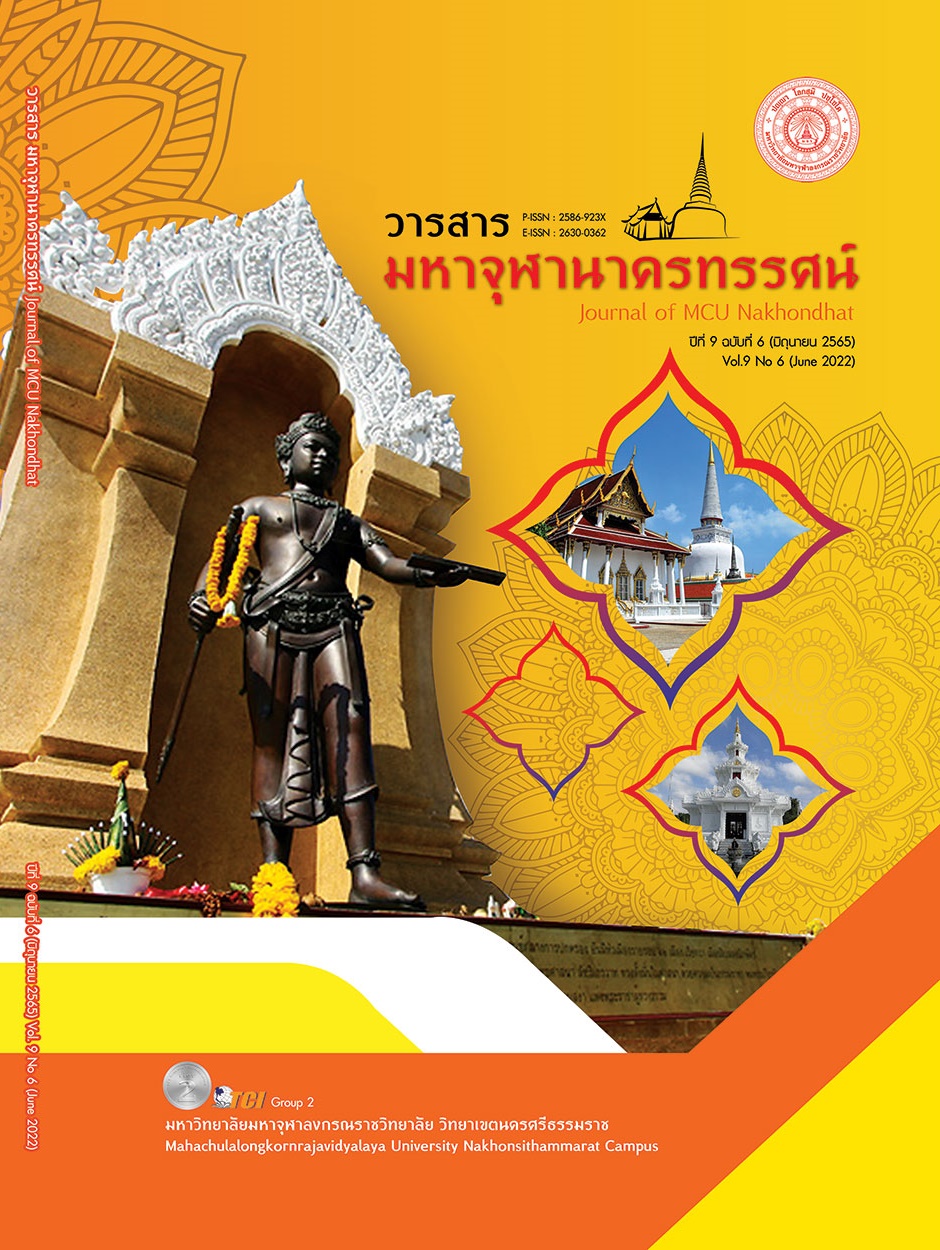PEACEFUL METHODS IN THE SITUATION OF THE COVID-19 VIRUS EPIDEMIC ACCORDING TO SÃRÃNĨYADHAMMA
Main Article Content
Abstract
The impact of the COVID-19 epidemic This makes most people insecure and safe in their lives. causing conflicts of thought and action The person who will do the duty to solve the problem completely is All people in society who will work together to create peace outside and peace within themselves and society. Nonviolence is the process of solving human problems. Not using violence will result in a peaceful society. according to the peaceful method of Buddhism The Buddha preached the Dharma principles as a guideline for fostering unity in society, consisting of the Threefold Principles used to create peace of one's body, mind, and wisdom. in order to reach the highest goal, which is nirvana, the principle of Saranee Dharma Dharma is a place of remembrance, namely 1) compassion for kamma 2) compassion for karma 3) mercy on mind 4) public welfare 5) silasamyata 6) dhitthisamanyata The principle of apocryphalism is Dharma that does not deteriorate For the happiness and prosperity of the practitioners, namely 1) keep meeting together for ever 2) unanimous meeting and adjourn the meeting; 3) will not prescribe anything that has not been stipulated will not revoke what has been commanded. 4) Worship, respect, venerate the elders; 5) not rape and rule over women; 6) worship, respect, venerate, venerate; It is a matter of precepts or rules that should be practiced together, the principle of mediation. The mediator must have a good heart. There is an understanding of the conflicting parties. in line with the principle of friendship Yonisomanasikan principle and the principle of forgiveness so it can be successful
Article Details

This work is licensed under a Creative Commons Attribution-NonCommercial-NoDerivatives 4.0 International License.
References
โพสต์ทูเดย์ออนไลน์. (2564). เปิด 17 ข้อผลงานล้มเหลวรัฐบาลประยุทธ์ จี้ครม.ลาออก. เรียกใช้เมื่อ 13 สิงหาคม 2564 จาก https://www.posttoday.com/ politic/news /655533
โอฬาร ถิ่นบางเตียว. (2564). วิพากษ์โควิดรอบ 3 ผลกระทบ-การแก้ปัญหา. เรียกใช้เมื่อ 11 สิงหาคม 2564 จาก https://www.matichon.co.th/politics/news_2673620
ไพโรจน์ อยู่มณเฑียร. (2549). วาทะธรรม : ว่าด้วยสันติภาพของพุทธทาสภิกขุ. กรุงเทพมหานคร: สำนักพิมพ์บ้านลานธรรม จำกัด.
ชัยวัฒน์ สถาอานันท์. (2539). สันติทฤษฎี-วิถีวัฒนธรรม (Peace theory and culturalelements). กรุงเทพมหานคร: มูลนิธิโกมลคีมทอง.
พระมหาหรรษา ธมฺมหาโส, ผศ.ดร. (2553). อภัยทานกับการสร้างความสมานฉันท์ในสังคมไทย. เรียกใช้เมื่อ 14 สิงหาคม 2564 จาก https://www.mcu.ac.th/ article/detail/453
พระมหาหรรษา ธมฺมหาโส. ผศ.ดร. (2564). “สันติวิธีทำไม ทำไม ต้องสันติวิธี”. เรียกใช้เมื่อ 14 สิงหาคม 2564 จาก http://oldweb.mcu.ac.th/userfiles/file
พุทธทาสภิกขุ. (2531). สันติภาพของโลก. กรุงเทพมหานคร: ธรรมทานมูลนิธิ.
มาร์ค ตามไท. (2543). การจัดการความขัดแย้งด้วยสันติวิธีในสันติวิธี : ยุทธศาสตร์ชาติเพื่อความมั่นคง. กรุงเทพมหานคร: สถาบันยุทธศาสตร์ สำนักงานสภาพความมั่นคงแห่งชาติ.
วันชัย วัฒนศัพท์. (2547). ความขัดแย้ง : หลักการและเครื่องมือแก้ปัญหา. พิมพ์ครั้งที่ 2. กรุงเทพมหานคร: สถาบันพระปกเกล้า.
หมัดเหล็ก. (2564). กรณีศึกษาความล้มเหลวจากโควิด. เรียกใช้เมื่อ 13 สิงหาคม 2564 จาก https://www.thairath.co.th/news/politic/2142132


